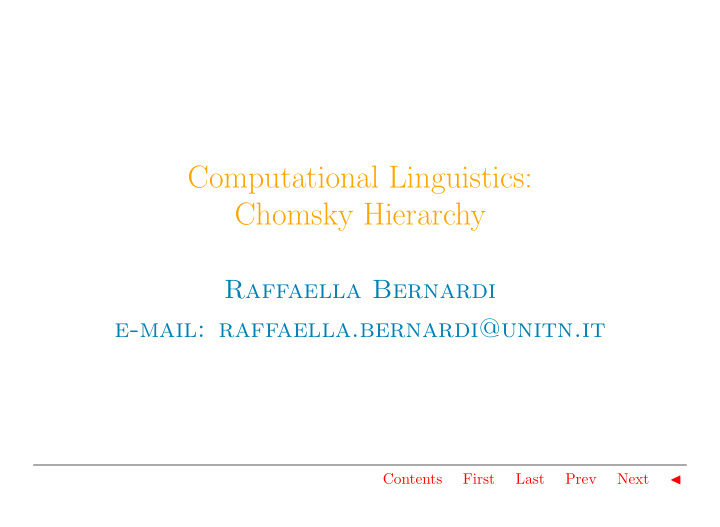



Computational Linguistics: Chomsky Hierarchy Raffaella Bernardi e-mail: raffaella.bernardi@unitn.it Contents First Last Prev Next ◭
1. Credits Remark Some of the slides (on Chomsky Hierarchy, etc.) are from Gerhard Jaeger course given at ESSLLI ’04. Contents First Last Prev Next ◭
2. Generative Power Every (formal) grammar generates a unique language. However, one language can be generated by several different (formal) grammars. Formal grammars differ with respect to their generative power . One grammar is of a greater generative power than another if it can recognize a language that the other cannot recognize. Two grammars are said to be ◮ weakly equivalent if they generate the same string language. ◮ strongly equivalent if they generate both the same string language and the same tree language. Contents First Last Prev Next ◭
3. Hierarchy of Grammars and Languages A hierarchy of grammars: the set of languages describable by grammars of grater power subsumes the set of language describable by grammars of less power. The most commonly used hierarchy is the Chomsky Hierarchy of Languages introduced in 1959. Hence, the two questions to ask are: ◮ Where does Natural Language fit in the Chomsky Hierarchy? ◮ Which is the generative power of the different Formal Grammars? If we know where NL fit, we would know ◮ which formal language can represent NL; ◮ which rules to use in writing formal grammars for NL. Contents First Last Prev Next ◭
4. Chomsky Hierarchy of Languages Contents First Last Prev Next ◭
5. Dissenting Views Claim: NL are not RL. ◮ all arguments to this effect use center-embedding ◮ humans are extremely bad at processing center-embedding ◮ notion of competence that ignores this is dubious ◮ natural languages are regular after all. Contents First Last Prev Next ◭
5.1. Are NL Context Free (CF)? History of the problem: 1. Chomsky 1957: conjectures that natural languages are not CF 2. sixties, seventies: many attempts to prove this conjecture 3. Pullum and Gazdar 1982: ◮ all these attempts have failed ◮ for all we know, natural languages (conceived as string sets) might be context-free 4. Huybregts 1984, Shieber 1985: proof that Swiss German is not context-free 5. Culy 1985: proof that Bambara is not context-free Contents First Last Prev Next ◭
5.2. Nested and Crossing Dependencies Contents First Last Prev Next ◭
5.3. Cross-serial dependencies Swiss German Today many theorists believe natural languages are not context-free. (Huybregts 1984, Shieber 1985). Evidences are given by cross-serial dependencies found in Swiss German where verbs and their argument can be orderded cross-serially. A sentence can have a string of dative nouns followed by a string of accusative nouns, followed by a string of dative- taking verbs, followed by a string of accusative-taking verbs. E.g. mer em Hans es huus halfed aastriiche we Hans/Dat the house/Acc helped paint. tr. we helped Hans paint the house. The number of verbs requaring dative objects must equal the number of dative NPs and similarly for accusatives, and this number can be arbitrary. Hence, the language representing this phenomenon is wa n b m xc n d m y which is not Context Free (CF). However, notice that those construction types used to prove that NLs is not CF Contents First Last Prev Next ◭
appear to be hard to understand for humans too. Contents First Last Prev Next ◭
6. Where does NL fit? How large NL are continues to be a less simple matter. There are two main non- compatible views: 1. Natural Language forms a class of languages that includes the CF family, but is larger than it. 2. Natural Language occupies a position eccentric with respect to that hierarchy, in such a way that it does not contain any whole family in the hierarchy but is spread along all of them The first view gave rise to a new family of languages which is of clear linguistic interest, Mildly Context-sensitive Languages . Contents First Last Prev Next ◭
7. Mildly Context-sensitive Languages (MSC) A concept motivated by the intention of characterizing a narrow class of formal grammars which are only slightly more powerful than CFGs , and which nev- ertheless allow for descriptions of natural languages in a linguistically significant way (Joshi 1985). According to Joshi (1985, p. 225) a mildly context-sensitive language, L, has to fulfill three criteria, to be understood as a rough characterization. Somewhat paraphrased, these are: 1. the parsing problem for L is solvable in polynomial time , 2. L has the constant growth property (i.e. the distribution of string lengths should be linear rather than supralinear.), and 3. there is a finite upper bound for L limiting the number of different instan- tiations of factorized cross-serial dependencies occurring in a sentence of L. Contents First Last Prev Next ◭
8. Where do the different Formal Grammars stand? The interest in the frameworks is tied to their generative power, . . . as well as their destiny . Chomsky’s formal language theory made it possible to ask for the generative strength of a grammar. After the discovery of languages which require cross-serial dependencies, grammars that were proved to be Context Free lost their appeal . Since CFGs were shown to be inadequate to model those natural languages. We are interested in the problem of determining whether a string is in the language generated/recognized by a grammar of a certain type. ◮ For Context Free Language the problem is polynomial. ◮ the same holds for Mildly CFL. ◮ whereas, for Context Sensitive Languages the problem is PSPACE-complete If NLs were CSL, this would be a bad news for CL! Contents First Last Prev Next ◭
9. Next class On the 5th of October, will discuss the content of this video: where do you stand? What is your opinion? During the online meeting (all in zoom 17:00-18:00), we will do pen-and-paper ex- ercises on: ◮ GFG and Formal Languages ◮ CFG and Natural Language Contents First Last Prev Next ◭
Recommend
More recommend